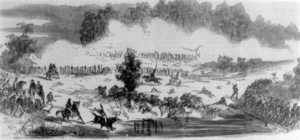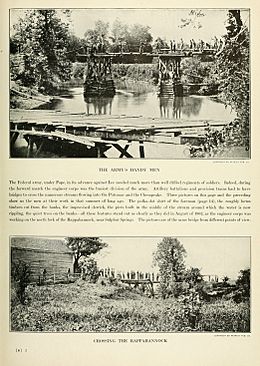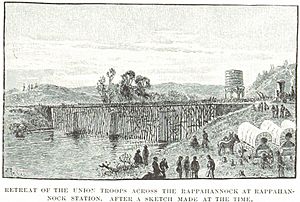First Battle of Rappahannock Station facts for kids
Quick facts for kids First Battle of Rappahannock Station |
|||||||
|---|---|---|---|---|---|---|---|
| Part of the American Civil War | |||||||
 Skirmish at Freeman's Ford, by Davenport. |
|||||||
|
|||||||
| Belligerents | |||||||
| Commanders and leaders | |||||||
| John Pope | James Longstreet | ||||||
| Strength | |||||||
| Brigades | Brigades | ||||||
| Casualties and losses | |||||||
| 225 | |||||||
The First Battle of Rappahannock Station was a fight during the American Civil War. It happened on August 23, 1862, in what is now Remington, Virginia. This battle was part of the larger Northern Virginia campaign. It involved soldiers from the Union (United States) and the Confederacy (Southern states).
Contents
Why the Battle Happened
In early August 1862, Confederate General Robert E. Lee learned something important. He found out that Union General George B. McClellan's army was moving away from the Virginia Peninsula. These Union troops were going to help Union General John Pope.
General Lee quickly sent his own troops to join up. He ordered General James Longstreet's soldiers to meet with General Thomas J. "Stonewall" Jackson's group. Lee himself arrived on August 15 to take charge. By August 20 and 21, General Pope's Union army had moved back. They set up their defense along the Rappahannock River.
Early Skirmishes Along the River
On August 20, General Pope spread his Union army out. They were on the north side of the Rappahannock River. Their goal was to protect the places where people could cross the river. These crossings stretched from Kelly's Ford up to Rappahannock Station.
At the same time, General Longstreet's Confederate soldiers reached Kelly's Ford. General Lee wanted to cross the river above Pope's army to surprise them. But Pope's army kept moving north too quickly.
On August 21 and 22, both armies kept moving north along the river. They were like dancers "waltzing" back and forth. Each army kept its southern end firmly at Kelly's Ford.
Then, General Lee changed his plan. He told General Jackson's troops to go much further upriver. They would cross the river above Pope's army. On August 23, Confederate cavalry, led by General J.E.B. Stuart, crossed the Rappahannock. They made a daring raid on Pope's headquarters. This showed that the Union army's right side was open to attack.
The Fight at Rappahannock Station
General Lee now needed to protect his own army's right side. Heavy storms on August 22 had made the river rise. This made most of the river crossings unusable. But Lee needed to capture the railroad bridge at Rappahannock Station. Union cannons on the high north bank controlled this important crossing. They also had a small group of soldiers and a cannon on the south bank.
On the afternoon of August 22, two Confederate artillery groups arrived. General Longstreet had ordered them to drive the Union soldiers away. They were to clear positions on both sides of the river. Two Confederate brigades, one from South Carolina and one from Georgia, were sent to help the cannons.
At dawn on August 23, 19 Confederate cannons began firing. This three-hour battle of cannons was very intense. It involved almost 50 cannons in total. The first target was the small Union cannon on a hill south of the river. This spot was easy for both armies to hit. Union forces quickly left this position. As they left, they blew up the railroad bridge.
Confederate soldiers then tried to take the hill. But Union cannons from across the river quickly forced them away. Around noon, some Union cannons moved upriver. This allowed them to fire on the low ground where Confederate soldiers were hiding. The Confederate soldiers had to retreat under heavy fire. They suffered many injuries.
In the middle of the afternoon, more Confederate cannons arrived. They shelled the Union forces. The Union soldiers then set fire to the buildings in the small town. After that, they retreated.
On August 25, General Jackson's troops started marching early. They went further upriver to cross the Rappahannock. This move would go around Pope's right side. On August 26, Jackson's troops marched through Thoroughfare Gap. They captured Bristoe Station and destroyed Union supplies at Manassas Junction. This was far behind Pope's army. A few days later, General Longstreet's troops followed the same path. They joined Jackson's soldiers. This set the stage for the important Second Battle of Manassas.
A Soldier's Burial
In 1989, a team of scientists found something special. They were digging at the ruins of St. James Episcopal Church. They found the remains of a Confederate soldier. The team figured out he was from New Orleans. He was part of the Washington Artillery. This soldier was killed during the Battle of Rappahannock Station on August 23, 1862. The soldier was later reburied at St. James Cemetery in Brandy Station, Virginia.
Protecting the Battlefield
The American Battlefield Trust and its partners work to save historic battlefields. By November 2021, they had protected 869 acres (about 3.5 square kilometers) of this battlefield. It is located along the Rappahannock River in Remington, Virginia. You can still see old earthworks (dirt walls built for defense) there. You can also see the ruins of the bridge and a mill.
See also
 In Spanish: Primera Batalla de Rappahannock Station para niños
In Spanish: Primera Batalla de Rappahannock Station para niños




